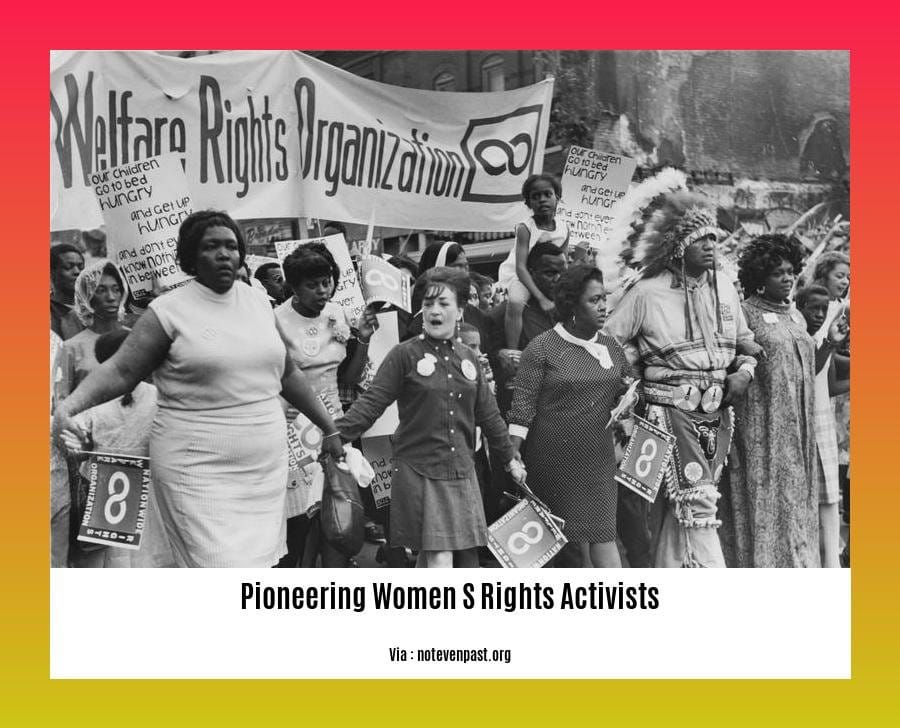Dive into the captivating stories of Pioneering Women’s Rights Activists: Their Stories, Achievements, and Legacy. Discover the remarkable journeys and groundbreaking contributions of trailblazing women who fought for equality, justice, and a better world for all.
Key Takeaways:

- Women’s rights activists have advocated for reproductive rights as human rights.
- MSI United States supports access to safe abortions and contraception.
- MSI provides contraception and education to women globally.
- Women’s rights activists have fought for numerous causes, including the right to vote, equality in the workplace, and reproductive rights.
Pioneering Women’s Rights Activists: Reshaping the World
Throughout history, pioneering women’s rights activists have fought tirelessly to dismantle societal barriers and secure equal rights for all. Their courageous efforts have left an indelible mark on our world, shaping the way we live and empower women.
Their Stories
These pioneering women’s rights activists came from diverse backgrounds and faced unique challenges. From the suffragettes who fought for the right to vote to the civil rights activists who challenged racial discrimination, each left an inspiring legacy.
Emmeline Pankhurst, the renowned suffragist, famously said, “I declare myself a rebel against the laws that rob me of my citizenship.” Her unwavering determination helped pave the way for women’s political empowerment. Similarly, Rosa Parks’ iconic refusal to give up her seat on a bus sparked the Montgomery Bus Boycott, a pivotal moment in the civil rights movement.
Their Achievements
The pioneering women’s rights activists achieved remarkable feats, including:
- Securing the right to vote for women
- Ending legal discrimination based on sex
- Expanding access to education and employment opportunities
- Raising awareness about reproductive health and rights
Their accomplishments transformed society, creating a more just and equitable world for women and girls.
Their Legacy
The legacies of pioneering women’s rights activists continue to inspire and empower generations to come. Their stories remind us of the power of collective action and the importance of fighting for what we believe in.
Through their tireless efforts, these women have made it possible for women to participate fully in all aspects of society. Their legacy is one of progress, equality, and human rights for all.
Delve into a compendium of influential feminist leaders and activists who tirelessly championed women’s rights, shaping the world we live in today. influential feminist leaders and activists for women’s rights
Meet the greatest feminists who fought for equality, overcoming adversity to achieve significant milestones for women’s rights. greatest feminists who fought for equality
Explore the profiles of famous feminist leaders and their causes, highlighting their unwavering commitment to advancing women’s empowerment. famous feminist leaders and their causes
Elizabeth Cady Stanton and the Declaration of Sentiments
Elizabeth Cady Stanton, a pioneering women’s rights activist, played a pivotal role in the women’s rights movement. She co-organized the First Women’s Rights Convention and co-authored the Declaration of Sentiments in 1848, which boldly declared that women deserved equal rights, including the right to vote.
The Declaration of Sentiments became a cornerstone of the women’s rights movement, articulating a vision of equality and autonomy for women. Stanton’s unwavering advocacy for women’s rights, alongside her partnership with Susan B. Anthony, helped to mobilize and empower women in their struggle for equality.
Key Takeaways:
- Pioneer of the Women’s Rights Movement: Elizabeth Cady Stanton was a driving force behind the movement for women’s rights in the United States.
- Declaration of Sentiments: Co-authored by Stanton, this document called for women’s equal rights, including the right to vote, property ownership, and education.
- Collaboration with Susan B. Anthony: Stanton’s partnership with Anthony was crucial in advancing the women’s suffrage movement.
- National Woman Suffrage Association: Stanton served as president of this organization, which played a prominent role in securing women’s right to vote.
- International Council of Women: Stanton co-founded this international organization to promote women’s rights worldwide.
- Legacy of Activism: Stanton’s tireless efforts laid the foundation for significant legal and social changes for women, leaving an enduring legacy of activism and advocacy.
Citation:
Sojourner Truth and Abolitionism
A Voice for the Oppressed
Sojourner Truth emerged as a powerful voice in the fight against slavery and for women’s rights in the 19th century. Escaping bondage, she dedicated her life to advocating for the marginalized.
Abolitionist Crusader
Truth became a vocal advocate for the abolition of slavery. She traveled the country, sharing her experiences and urging people to reject slavery’s evils. Her speeches and writings resonated with audiences, galvanizing support for the anti-slavery cause.
Intersectionality in Advocacy
Truth refused to separate the fight for racial equality from the struggle for women’s rights. Her famous speech, “Ain’t I a Woman?” challenged societal norms that devalued Black women. She demanded equal treatment and dignity for all, regardless of race or gender.
A Legacy of Courage
Sojourner Truth’s unwavering commitment to justice left an indelible mark on history. Her activism paved the way for the abolition of slavery and inspired generations of activists to fight for equality. Her legacy reminds us of the power of a courageous voice in confronting injustice.
Key Takeaways:
- Sojourner Truth escaped slavery and became a prominent abolitionist.
- She advocated for the abolition of slavery and women’s rights simultaneously.
- Her iconic speech, “Ain’t I a Woman?”, challenged societal norms and demanded equality.
- Sojourner Truth’s legacy as a courageous advocate for justice continues to inspire activists to this day.
Citation:
Harriet Tubman and the Underground Railroad
Key Takeaways:
- Harriet Tubman escaped slavery in 1849 and became known as “The Moses of Her People”.
- She helped over 300 slaves escape to freedom via the Underground Railroad.
- Tubman led dangerous missions to rescue slaves, despite the Fugitive Slave Act.
- Her courage and determination made her a symbol of the fight against slavery.
Harriet Tubman, born Araminta Ross, escaped slavery and dedicated her life to helping others escape the horrors of bondage. She played a crucial role in the Underground Railroad, a clandestine network of routes and safe houses helping slaves reach freedom in the North.
Harriet Tubman’s Journey to Freedom
Harriet Tubman’s path to freedom began with her own escape. She fled Maryland in 1849, navigating treacherous routes and evading bounty hunters. Her successful journey sparked her determination to aid others in their quest for liberation.
Harriet Tubman’s Role in the Underground Railroad
As a conductor on the Underground Railroad, Harriet Tubman organized and led daring missions to rescue slaves. She planned clandestine routes, arranged safe houses, and outsmarted slave catchers. Her ingenuity and bravery became legendary, and she earned the nickname “The Moses of Her People.”
Despite the Risks, Harriet Tubman Remained Undeterred
The Fugitive Slave Act of 1850 made Harriet Tubman’s work even more perilous. However, she refused to be deterred. She disguised herself, adopted different aliases, and employed clever tactics to evade detection. Her unwavering determination and resourcefulness ensured the safety of those she helped.
Harriet Tubman’s Legacy
Harriet Tubman’s legacy as a freedom fighter and advocate for justice continues to inspire. Her story reminds us of the resilience, courage, and determination required to fight against oppression. Her contributions to the abolitionist movement and women’s rights earned her a place among the most influential figures in American history.
Citation:

FAQ
Q1: What were the main goals of the women’s rights movement?
A1: The women’s rights movement advocated for equal rights for women, particularly the right to vote, education, employment, and property ownership.
Q2: Who were some of the key leaders of the women’s rights movement?
A2: Elizabeth Cady Stanton, Susan B. Anthony, Sojourner Truth, and Harriet Tubman were among the most prominent leaders of the women’s rights movement.
Q3: What were some of the challenges faced by women’s rights activists?
A3: Women’s rights activists faced resistance from society, including opposition from men and women who believed that women should not have the same rights as men.
Q4: How did women’s rights activists contribute to social progress?
A4: Women’s rights activists played a crucial role in advancing social progress by advocating for legal and social changes that improved the lives of women.
Q5: What is the legacy of the women’s rights movement?
A5: The legacy of the women’s rights movement includes the recognition of women’s rights as human rights and the ongoing struggle for gender equality.
- Unlock 6000+ words beginning with he: A comprehensive analysis - April 20, 2025
- Mastering -al Words: A Complete Guide - April 20, 2025
- Master Scrabble: High-Scoring BAR Words Now - April 20, 2025
















